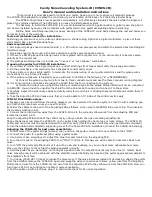
12
13
When Quick DO Cal is enabled, press and hold the calibration
key for 3 seconds while in the Run screen. Next, highlight Dissolved
Oxygen and press enter to calibrate the DO sensor to the instrument’s
barometer reading. For more information on Quick DO Cal, see the
Calibration section of this manual.
AUDIO
Audio can be enabled by highlighting Audio and pressing enter. When
enabled, there will be an ‘X’ in the box next to Audio.
When Audio is enabled, the Pro1020 will beep twice to indicate stability
when Auto Stable is enabled. The instrument will also beep when a key
is pressed. When Audio is disabled, the Pro1020 will not beep.
CONTRAST
To adjust the display Contrast, use the up or down arrow keys to
highlight Contrast, then press enter. Next, use the up or down arrow
keys to adjust the contrast. The up arrow key will darken the contrast
and the down arrow key will lighten the contrast. After adjusting the
contrast, press enter to save and exit the Contrast adjustment function.
ALTERNATE CONTRAST ADJUSTMENT OPTION
If necessary, there is an alternate method of adjusting the contrast. To
adjust the contrast, press and hold the menu key, then press the up
arrow key to darken the contrast or press the down arrow key to lighten
the contrast.
DO SENSOR TYPE
DO Sensor Type sets the type of dissolved oxygen sensor being used;
either polarographic (black) or galvanic (grey).
Use the up or down arrow keys to highlight Sensor Type, then press
enter to open a submenu. Highlight the sensor type corresponding
to the sensor installed on the cable and press enter to confirm. The
enabled sensor type will have an ‘X’ in the box next to it. Next, use the
down arrow key to highlight the ESC – Exit box, then press enter to
save changes and to close the sensor submenu.
The Pro1020 has two compatible sensors for use with a field cable:
•
Polarographic – This sensor has a black sensor body and is engraved
with the model number 2003. Polarographic will be abbreviated
Polaro in the instrument menu.
•
Galvanic – This sensor has a grey sensor body and is engraved with
the model number 2002.
In terms of physical configuration, membrane material and general
performance, YSI Pro Series galvanic sensors are exactly like the Pro
Series polarographic sensors. The advantage of using galvanic sensors
is convenience. Galvanic sensors provide an instant-on sensor without
the need for warm-up time but this affects the life of the sensor.
Polarographic sensors last longer and have a longer warranty but
require a 5-15 minute warm-up time before use or calibration.
MEMBRANE TYPE
Membrane Type sets the type of membrane used on the dissolved
oxygen sensor; either 1.25 PE (Yellow) or 2.0 PE (blue). Use the up
or down arrow keys to highlight Membrane Type and press enter to
open the submenu. Highlight the membrane type corresponding to
the membrane installed on the sensor and press enter to confirm. The
enabled membrane type will have an ‘X’ in the box next to it. Use the
down arrow key to highlight the ESC – Exit box and press enter to save
changes and to close the membrane submenu.
The dissolved oxygen sensor is supplied with membranes specific
to the sensor type and are color coded as described in the following
tables.
Galvanic Membrane Kits:
Model
Color
Material
Description
5913
Yellow 1.25 mil
polyethylene (PE)
Faster response time and less flow
dependence than traditional FEP
membranes.
5914
Blue
2.0 mil
polyethylene (PE)
Less flow dependence than 1.25 mil
membrane but little slower response.
Polarographic Membrane Kits:
Item
Color
Material
Description
5908 Yellow 1.25 mil
polyethylene (PE)
Faster response time and less flow
dependence than traditional FEP
membranes.
5909
Blue
2.0 mil
polyethylene (PE)
Less flow dependence than 1.25 mil
membrane but a little slower response.











































